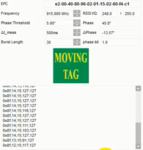F-Moura
Junior Member level 2

Hello Guys,
I have a new project that I want use RFID to verify ID of item and I need measurement distance from reader to TAG. The maximum distance between the reader to TAG is about 7 cm and I want know distance between reader to TAG with accuracy about 1 cm.
Is it possible?
I have a new project that I want use RFID to verify ID of item and I need measurement distance from reader to TAG. The maximum distance between the reader to TAG is about 7 cm and I want know distance between reader to TAG with accuracy about 1 cm.
Is it possible?



